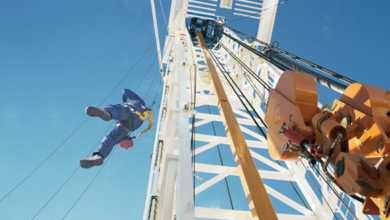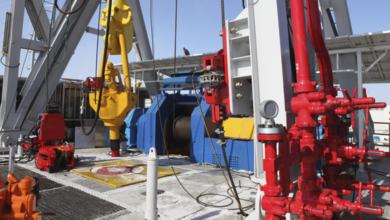Perspectives
Kristin Falk, Ocean Riser Systems: Extending the benefits of MPD to floaters
by Diane Langley, editorial coordinator

In an industry in which technology innovation is paramount, Dr Kristin Falk fits right in. “Developing new technologies and applying them in the field is my passion,” Dr Falk, senior manager of managed pressure drilling (MPD) controls solutions for Ocean Riser Systems, said.
Right out of high school, Dr Falk pursued engineering with an emphasis on applied mathematics. These studies were followed by petroleum engineering. “My interest in math and physics came very early. I always wanted to work with numbers and science. But in what field was not clear to me,” Dr Falk said.
“I got my first contact with the petroleum industry when I started working with risk management in Scandpower straight out of university,” she said. “With my mathematical background, I knew very well how to calculate the risk of blowouts and other accidents. But that was not enough. I also wanted to understand what was happening and be able to engineer good solutions.”
She then embarked on the path of petroleum engineering when she undertook a PhD program at the Norwegian University of Science and Technology, where she performed experiments, field testing and numerical modeling on pressure propagation in multiphase wells. Her experiments were performed at the Atomic Energy Centre in Grenoble, France, where she stayed for a year with a scholarship from Total. Her work toward a master’s degree in industrial mathematics at the same university in Norway involved the dynamic aspect of deepwater mooring lines. A year of her master’s studies was spent at the University of California at Berkeley, giving Dr Falk an introduction both to American culture and also to advanced math.
After completing her PhD she worked with flow assurance, production optimization and subsea processing in ABB research and development and then in Aker Solutions. Dr Falk’s current work on MPD for Ocean Riser Systems affords her an opportunity to develop leading-edge technologies.
“When I joined Ocean Riser Systems in 2008, the concepts were already there, but over the last three years MPD has matured in people’s and companies’ minds and we’re seeing a much broader demand for the systems now,” Dr Falk said. “Demand is there, but the widespread use of the technology is not there yet.”
Dr Falk agrees with the statements being made that MPD is changing drilling engineering for future generations. On land, the industry has come quite far in using MPD, she said. Some of this technology has moved offshore mainly on fixed to seabed platforms with dry trees. While there is big potential for the use of MPD from floating vessels, this potential has not yet been fully realized.
Dr Falk believes that, when its offshore use from floaters does become more prevalent, MPD can improve the casing program and well integrity in subsea wells, especially in deepwater. Its use can achieve operational efficiencies not possible with conventional drilling methods and increase operational safety. According to Dr Falk, MPD and dual gradient drilling from floaters has the potential to improve operational safety by providing faster and more accurate well control, while more effectively adapting to the pressure margins given us by nature.
The technology can also improve operational efficiency by reducing the overall non productive time and can drill longer sections faster between each casing point. Additonally, the technology can be used to improve the quality of wells by improved casing cementing and zonal isolation, reduced formation damage and improved completion operations and procedures. Finally, the technology enables increased automation and better work processes, she said.
According to Dr Falk, the industry is challenged by increasing complexity, such as deeper water, deeper fields, longer wells, HPHT, depleted reservoirs and salt. This leads us to complex and heterogeneous pressure regimes, where the existing technology is stretched to its limits, she said.
“We have to remember that today’s method of pressure regulation during drilling has not changed materially since the beginning of drilling. We need a new drilling method to reduce cost and risk and to increase revenue from subsea wells. This involves a safer drilling method with increased drilling speed and a decrease in nonproductive time that would make reservoir sections drillable and increase production and recovery rates,” Dr Falk said. “That is, we need a MPD method fitted to subsea and deepwater drilling conditions.”
Dr Falk points out that well safety and well integrity issues have become a major issue in subsea MPD and that there are more and more challenging wells that need to be drilled. Further, subsea fields are becoming depleted; meaning that the drilling window is closing for major oil and gas fields in medium to deepwater. The well cost is going up. Also, the use of “open” MPD systems without trapped pressure in the well, riser or on the rig is now more widely accepted as a safe approach to achieve constant bottomhole pressure and to fit mud gradient to the drilling window.
Using pressurized MPD on land, drillers and choke operators have to be constantly on the alert because small variations in boundary conditions may equate to big changes in well pressure. From floaters that heave and move constantly, the ideal solution may not be a very fast response to pressure management since drilling conditions are very different than on land and from fixed seabed platforms. Also, in deepwater, the drilling window requires a “dual-gradient” type method to optimize the casing program and to fit the mud gradient in between the pore and fracture pressure.
Bringing enthusiasm for her work and for tackling the technology challenge always present in the industry, Dr Falk became a member of the IADC MPD and UBO Committee in 2009 and has played an active role in developing a software program for MPD selection. The tool tells the engineer which MPD method to use for a specific application.
She has also been involved in the creation of the dual gradient drilling subcommittee and serves as the committee vice chair. The subcommittee’s vision is to facilitate the safe and efficient exploitation of hydrocarbon utilizing dual-gradient technologies.
“MPD represents new opportunities to drilling personnel. I look forward to helping the industry utilizing this technology. I like that there are still challenges out there that should be resolved,” she said.
Drilling the undrillable is the ultimate technology challenge. Dr Falk stands ready to tackle it.



